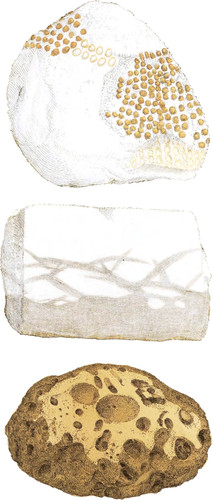 Enlarge
Enlarge
British Mineralogy
Common Chalk
- Class 2. Earth.
- Order 1. Homogeneous.
- Gen. 1. Lime.
- Spec. 2. Carbonate of Lime.
- Div. 3. Amophous.
- Syn.
- Chalk. Kir. v. 77.
- Craie compacte. Born, v. 1. 281.
- Chaux carbonatée crayeuse. Haüy, v. 2. 166.
- Creta scriptoria. Linn. Syst. Nat. v. 1. 206. Gmel. v. 3. 86.
Albion cliffs, famed of old, are the chalk-hills of Dover in Kent, and chalk is sufficiently known to abound in many parts of Britain.
There is no chalk in Cornwall*. Chalk is understood to be a precipitation of carbonate of lime, holding a little clay and some flinty particles. It is often in very thick strata, frequently under sand. Flints in strata and of irregular forms are very common in it, and sometimes flints full of flaws, as if mouldering to pieces. Thestratum is mostly horizontal, but sometimes otherwise, as at the Isle of Wight†. Many remains of animal exuviæ are found in chalk, as shells, echini, corals, &c. and with the rhombic fracture: sometimes the echinites are filled with perfect flints. Martial pyrites, or sulfure of iron, is not uncommon in it, either in full metallic splendor, or in different states of decomposition passing into ochre or oxid of iron. It is remarkable that Mr. Kirwan, in his Geological Essays, p. 238, says that metallic substances are never found in chalk. Werner Kal. Classif. 19. Berg. Kal. 232. Yet in France martial pyrites are said to be found in it, 39 Roz. 358; as if it were not found in England. Pyrites are found in the chalk of Sussex; I have found them from Dover to Margate; at Godstone also in great bundance, where the chalk in various ways passes into fine-grained micaceous lime-stone called fire-stone, brought in abundance from Ryegate.
The upper figure is meant to represent a lump of chalk from Sussex, which has a conical fracture not uncommon in chalk, and sometimes in flint. The little granulæ of fine gravel so regularly formed about it, seem to be a filtration of water carrying sand with it through some loose chalk, which meeting with a more compact piece runs down the sides in drops, and at the same time is absorbed by the chalk, leaving the sand on the surface in little globules. There are sometimes large quantities of sand in the chalk which fall in occasionally, and are called by the workmen sand gulls.
Middle figure. Chalk passing into lime-stone, hardening with inosculating veins.
The lower figure represents a piece of chalk rounded by rolling about in the sea, perforated by the Mytilus rugosus, or some species of Pholas: being stained it loses the appearance of chalk. Harder substances are often perforated by testaceous animals.
Bryum calcareum, English Botany. t. 191, should seem to indicate good chalk, as I have found the best where it grows.
- * Dr. Maton’s Tour to the Western Counties.
- † Sir H. C. Englefield in Linn. Trans. v, 6.

